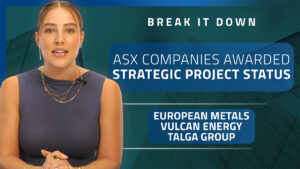Here’s why more and more miners are suddenly scrambling for an ESG solution

ESG credentials are becoming more important in the mining industry. Pic: Francesco Carta fotografo (Moment) via Getty Images.
Environmental, social and governance (ESG) credentials are picking up steam in the mining industry.
Envirosuite (ASX:EVS) CEO Jason Cooper said in the last 12 months the company has had “significant uptick” from senior management in mining companies for its ESG platform.
“The companies have certain requirements from their investors to support greater transparency around environmental, social and governance impact, as well as some of the UN’s Sustainable Development Goals,” he said.
“And this certainly has been driving discussions with senior management about our predictive modelling tools and software.”
Cooper said the sector is a good market opportunity for the company – but that mining companies need ESG programs to support their operations.
“I would argue that you can’t operate a mine site effectively without our platform,” he said.
“We know that we have got the broadest capability of anybody in the world.
“And I think [going forward] what you’ll see is a real groundswell around environmental intelligence – we will learn more and more through the data sets that we capture, which will then feed into creating better insight.”
Environmental intelligence platform
The company recently announced bumper annual recurring revenue (ARR) of $46.5 million for FY21, and ARR for its Omnis product grew 24% over the year.
Omnis is an environmental intelligence platform, where the company can connect a range of environmental parameters like dust vibration, odour, water quality, air quality and noise, and use their predictive algorithms to forecast future scenarios based on the mine asset, location, and meteorological surroundings.
“Probably around 30-40% of Omnis revenue would be from resources,” Cooper said.
“We can combine weather sensors, air quality and dust sensors and use our software to understand where that dust will go.
“We can use our forecasts to minimise the impact on the environment and on local communities.
“So, mine companies can use this as a planning tool, which is especially relevant when you think about the amount of money they spend on dust mitigation.”
Social licence to operate
This all ties in with a company’s social licence to operate.
Cooper said that Envirosuite also works with mines on different community expectations around engagement about their projects.
“What we can do is work with the community a) as a communication portal, and b) depending on the mining company, provide a degree of transparency about what is happening on a particular site,” he said.
“So, we would have noise monitoring, so the company understands when’s the right time to do blasting based on the trajectory of that blast from the noise dissipation perspective, understanding the topography, the land, and where that sound will travel.
“So, instead of having the sound be a significant impact on the community from blasting, we can do it when the wind is blowing away from the community, which has a significant benefit to them.
“We can also help monitor vibration and give the company insight into that aspect of their operation.”
Water management is vital
Envirosuite also works with water management on mine sites to understand the impact of water flow, monitoring it and how the company is using the water.
Magnetite Mines (ASX:MGT) head of stakeholder engagement Allan Kane said water management was a key part of the company’s ESG program for its Razorback iron ore project in South Australia.
“We’re situated in a sheep grazing area, and rainfall and the availability and the security of water supply is really important to the farmers and the pastoralists that surround us,” he said.
“And they’re making sure that we are aware of that when we’re designing our project and looking at what options we have for our own water supply.
“It’s about working with our stakeholders on water management because we understand that water availability is a critical issue for them.”
Stakeholder engagement key for MGT
Kane said that stakeholder engagement is a key to the company’s development of the project.
“We’ve started our early engagement with some of the other key stakeholders, and that includes First Nations, local land holders, communities and other local vested interest groups.
“We can start to understand what are the issues that really matter to them which gives us a fantastic opportunity to take consideration of those priorities that our stakeholders have as a part of our project design process.
“It’s really important for us to understand the context of the area that we’re working in, on an environmental, land management, and social perspective.”
Investors looking for ESG conscious companies
Kane also said that the company accepts that its position in the iron ore market will be heavily influenced by ESG performance and the expectations of customers – and that if ESG standards are important to investors they need to continue to communicate that message with miners like MGT.
“Whether that’s our carbon footprint, or the sustainability of our local resource use, we know that there are issues that are not just important now, but will become critical into the future,” he said.
“It’s going to be a sustained process. It’s a commitment we have through the full lifecycle of the project.”
Related Topics
SUBSCRIBE
Get the latest breaking news and stocks straight to your inbox.
It's free. Unsubscribe whenever you want.
By proceeding, you confirm you understand that we handle personal information in accordance with our Privacy Policy.








